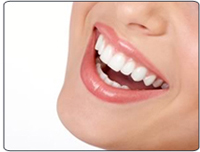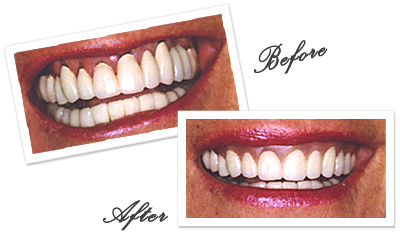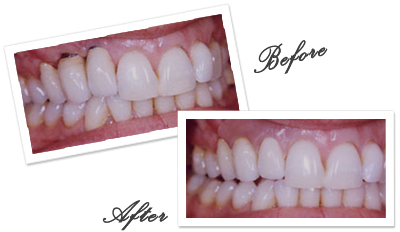|
 When patients lose teeth, they also lose the supporting alveolar
bone and gingival architecture. Surgical procedures are available
today to rebuild these deficits and to provide an esthetic
framework for tooth replacement. However, when surgical procedures
are contraindicated, or when it is impossible to adequately
replace the amount of lost gingival architecture, prosthetic
replacement is indicated.
When patients lose teeth, they also lose the supporting alveolar
bone and gingival architecture. Surgical procedures are available
today to rebuild these deficits and to provide an esthetic
framework for tooth replacement. However, when surgical procedures
are contraindicated, or when it is impossible to adequately
replace the amount of lost gingival architecture, prosthetic
replacement is indicated.
Removable dentures routinely incorporate the lost gingival
tissue in the flanges using shades of pink-colored acrylic
resin. Porcelain fused to gold bridges, either supported by
natural teeth or implants, may include pink-colored porcelain
to achieve the same result. This allows replacement of the
soft- and hard-tissue deficits without leaving dark spaces
between the teeth and soft tissue or having large clinical
crowns.
A technique is available for crown and bridge restorations
to replace the missing soft-tissue contours independent of
a fixed prosthesis. This is accomplished by means of a removable
gingival replacement unit, sometimes referred to as a gingival
mask.
Patients should be instructed on proper care of the prosthesis,
ie, to handle with care, clean with a brush and denture toothpaste,
and soak in water in a denture cup at night.
Applications for a removable gingival replacement unit, or
a gingival mask, are as follows:
(1) to cover exposed crown margins
(2) to cover exposed implant components
(3) to cover root surfaces and reduce the length of the clinical
crown
(4) to block out the black triangles between teeth in which
gingival recession has occurred
(5) to fill in the space between the crown and the soft tissue
(6) prevent air flow through or beneath maxillary fixed restoration,
improving phonetics; (7) to provide increased lip and cheek
support for those patients who require it.
The advantage of this technique is that it allows for easy
replacement of the soft tissue for improved esthetics while
permitting easy access for oral hygiene procedures.
Aside from being a removable prosthesis, the only apparent
disadvantage is the potential for fracture because of its
delicate nature. However, considering the large population
who use ocular prostheses or a similar design and retention
concept (contact lenses), patients seem to readily adapt to
their use and have been known to wear them for years, even
after they fracture.
In summary, the advantages of the gingival replacement unit
are numerous, including improved esthetics and phonetics while
maintaining the opportunity for open embrasures and easy access
for oral hygiene.


|


 When patients lose teeth, they also lose the supporting alveolar
bone and gingival architecture. Surgical procedures are available
today to rebuild these deficits and to provide an esthetic
framework for tooth replacement. However, when surgical procedures
are contraindicated, or when it is impossible to adequately
replace the amount of lost gingival architecture, prosthetic
replacement is indicated.
When patients lose teeth, they also lose the supporting alveolar
bone and gingival architecture. Surgical procedures are available
today to rebuild these deficits and to provide an esthetic
framework for tooth replacement. However, when surgical procedures
are contraindicated, or when it is impossible to adequately
replace the amount of lost gingival architecture, prosthetic
replacement is indicated. 
